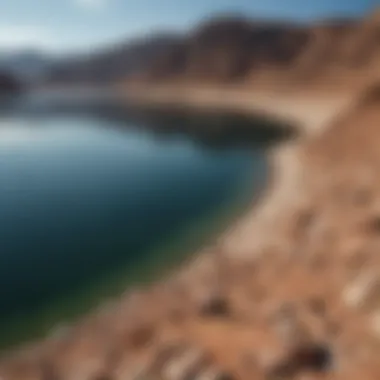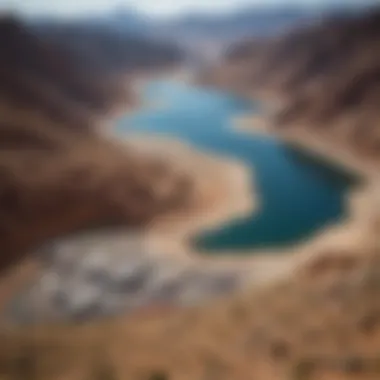Lake Mead's Future: Challenges and Solutions Ahead


Intro
Lake Mead, the largest reservoir in the United States, has become a central point of concern in discussions around water management and sustainable practices. As we peel back the layers of its current predicament, the factors surrounding this beautiful expanse of water reveal themselves to be as intricate as the ecosystems it supports. This article investigates the challenges posed by declining water levels, the amplifying effects of climate change, and the far-reaching impacts on the communities that depend on this vital resource.
By addressing these interconnected issues, we hope to shed light on the need for urgent and adaptive management strategies that can balance environmental health with human needs. Deciding the course for Lake Mead means navigating economic, ecological, and social dilemmas— a task that's no walk in the park. Here, we will embark on an in-depth exploration of these challenges and propose paths forward as we highlight what’s at stake for the future of this crucial watershed.
Foreword to Lake Mead
Lake Mead represents a critical resource that intertwines the multifaceted aspects of water supply, ecological balance, and economic vitality in the southwestern United States. Understanding its intricacies not only provides insight into the pressing challenges it faces but also highlights its pivotal role in maintaining the region's sustainability. As a vital reservoir born of the Hoover Dam, its water levels are influenced by a mix of climate patterns, legislative changes, and local communities who depend on it for their daily lives.
Geographical Overview
Nestled within the stunning scope of Nevada and Arizona, Lake Mead stretches over an impressive 247 square miles. This expanse is not just a body of water; it's a reservoir that can hold around 28 million acre-feet of water. Formed by the Colorado River, it stands as one of the largest man-made lakes in the United States. The landscape surrounding Lake Mead is as diverse as it is picturesque, featuring arid deserts juxtaposed with rugged mountains.
The surrounding area includes several towns, such as Henderson and Boulder City, playing a significant role in the lives of thousands. These locations provide a glimpse into how vital Lake Mead is for local water supplies. For recreational enthusiasts, from boating to fishing, Lake Mead's geographical features are enticing enough to attract visitors year-round.
Historical Significance
Lake Mead's history is deep-rooted, marked by the construction of the Hoover Dam, which started in the early 1930s. This monumental project aimed to control flooding, provide irrigation, and deliver hydroelectric power. More than just a significant engineering achievement, the dam facilitated the formation of Lake Mead, altering the landscape and economy of the region forever.
During its early years, the lake symbolized hope and prosperity during the Great Depression, offering jobs and inviting growth in tourism. Over the decades, Lake Mead has been a linchpin for agriculture, recreational activities, and urban development, supporting millions of residents across several states.
The site has not only served as a reservoir but has also become a treasured part of American culture. It is home to the Lake Mead National Recreation Area, established in 1964, which echoes the historical significance of preserving natural resources for future generations.
In summary, the geographical and historical significance of Lake Mead sets the stage for understanding its current state and the challenges it faces as we explore potential solutions to its ever-growing dilemmas. Its influence permeates through state lines, emphasizing the necessity of sustainable management and prompting vital discussions on the future of this crucial water source.
Current State of Lake Mead
Understanding the current state of Lake Mead is critical if we want to grasp the challenges it faces. This vast reservoir doesn’t just serve as a water source. It’s intertwined with the livelihood and lifestyle of many communities. As water levels drop to historic lows, the ripple effects touch everything from local economies to ecology. It's crucial to look closely at the data emerging from this vital water body, as it highlights the urgency of our current situation while painting a broader picture of what the future may hold.
Water Level Trends
Looking at the water level trends gives us a clearer picture of the root issues at play. In the last two decades, Lake Mead's water levels have exhibited a stark decline, primarily due to ongoing drought in the Southwestern United States. Several factors contribute to this alarming plunge, including climate change and increased water consumption. Data collected over the years shows that in 2000, the lake was at 1,205 feet above sea level. Fast forward to recent years, and the water level has dipped to around 1,067 feet. This reduction is not merely a statistic; it impacts not only the volume of water available but also the ecosystems thriving around the lake.
Observing the trends, we find that the seasonal variations in precipitation and temperature also play significant roles. Climate scientists note that decreasing snowfall in the Rockies, the primary source of water feeding Lake Mead, has compounded the issue. Therefore, monitoring these water level trends serves as a bellwether for us, signaling possible consequences for the future.
Ecological Impact
The ecological impacts associated with the fall of Lake Mead's water levels deserve thorough consideration. As temperatures soar, the water's ecology begins to shift, markedly affecting both flora and fauna.
Flora and Fauna
When discussing the flora and fauna surrounding Lake Mead, it’s vital to recognize their interdependence. The persistent low water levels have created conditions unsuitable for many aquatic plants and fish species. For instance, submerged vegetation, which provides essential habitats and food sources for aquatic life, is disappearing. The unique characteristic of this vegetation is its ability to filter water and stabilize the ecosystem but dwindling habitat diminishes its effectiveness.
Moreover, the fish species, especially those native to the region, are struggling to cope. Habitat loss is reshaping local ecosystems in ways that are difficult to predict. Without a robust plant undergrowth, various insect populations are also affected, which cascades through the food web. This kind of change can lead to reduced biodiversity, further complicating an already complex ecological web.
Native Species Decline
The decline of native species in Lake Mead is another critical aspect causing concern. As habitats change, several species face the threat of extinction. Endemic fish, like the Lahontan cutthroat trout, have already faced drastic population declines due to habitat alterations and competition from invasive species.
This decline isn’t just a footnote; it's a pulse on the health of the ecosystem. A significant aspect of native species is their role in maintaining ecological balance. They often have evolved alongside their environment and are finely tuned to the specific conditions of Lake Mead. When these species disappear, the repercussions touch all corners of the ecosystem, from plant life to larger predators. The unique feature about these native species is that they contribute not only to biodiversity but also to local culture and economies that depend on fishing and recreation. The loss of these species could lead to far-reaching impacts, including reduced community engagement with the lake and its ecosystems.
Ultimately, the current state of Lake Mead is a multifaceted issue that demands our immediate attention. As we see both water levels decline and ecological systems shift, it’s a reminder that the time to act is now. We are not merely spectators to this unfolding situation; we are active participants in determining its fate.
"Water is life, and preserving our water resources is a step towards sustaining our future."
Through awareness and action, we can endeavor to mitigate these changes before it’s too late.
Climate Change and Its Implications
As the world grapples with the inevitable consequences of climate change, Lake Mead stands as a pivotal case study. The challenges it faces are intricately woven into the larger fabric of our climate crisis, making it not just a regional issue, but a bellwether for broader ecological and socioeconomic realities. Understanding the nuances of climate change, particularly how it affects this vital water source, is crucial for formulating effective strategies and policies moving forward.
Drought Patterns
Droughts are becoming more frequent and severe, raising alarms across the western United States. Lake Mead, primarily fed by the Colorado River, is particularly susceptible to these changing patterns. As rainfall becomes less predictable, the stark reality of dwindling water sources emerges. Over the last two decades, certain areas have witnessed a relentless upward trend in drought conditions.


The implications are far-reaching. Some key points to consider include:
- Water Supply Disruption: Continued drought can lead to reduced inflows to Lake Mead, exacerbating the already critical water levels.
- Agricultural Strain: Farmers relying on irrigation from this lake face severe challenges. Crop yields can decline, leaving many to question food security.
- Economic Fallout: The ripple effect of drought is tangible. Regions that depend on tourism and recreation related to Lake Mead could see declines in their income, further straining local economies.
"Drought is not just a weather-related event; it’s a complex crisis affecting livelihoods, ecosystems, and the very future of many communities."
Temperature Anomalies
In tandem with shifting drought patterns, temperature anomalies are also influencing Lake Mead's fate. Rising temperatures can amplify evaporation rates, leading to significant losses in water volume. The region has experienced an upward trend in average temperatures, which is concerning for water management strategies.
Consider these ramifications:
- Increased Evaporation: Hotter temperatures result in more rapid water evaporation, leading to even lower levels in the lake. This creates a cycle that fuels further resource depletion.
- Ecosystem Shifts: Aquatic life forms that thrive in certain temperature ranges may struggle or decline, leading to a domino effect that impacts the entire food web.
- Impact on Water Quality: Elevated temperatures can negatively affect the chemical composition of the lake water, increasing algae blooms which can compromise drinking water quality.
Mitigating these effects requires a multifaceted approach, combining technological innovation, community engagement, and legislative initiatives aimed at sustainable water use. The conversation around climate change and its implications for Lake Mead must not just center on the scientific data but also on actionable strategies that engage various stakeholders responsibly.
Socioeconomic Aspects
Understanding the socioeconomic aspects of Lake Mead is crucial in grasping the entirety of its ongoing crisis. These elements not only shed light on the dependence of communities on this vital water source but also reveal the intricate balance needed between human needs and ecological preservation. The challenges faced, encompassing areas like water supply debates and agricultural impacts, are intrinsically linked to broader societal dynamics.
Communities Dependent on Lake Mead
Water Supply Controversies
Water supply controversies surrounding Lake Mead highlight a significant tension between states and communities relying on its dwindling reserves. This issue revolves around agreements made decades ago, which now seem increasingly untenable as the lake's water levels continue to drop. Disputes often flare when states like California, Nevada, and Arizona vie for their share, leading to potential legal battles and heightened interstate relations.
The key characteristic here is the allocation of water rights based on historical usage rather than current needs. This has been beneficial for some regions, like agriculture-heavy California, but leaves urban areas in states like Arizona facing water scarcity challenges. Farmers and cities jostle over their entitlements, each side presenting compelling arguments about their necessity.
However, this controversy gives rise to unique features: The negotiation processes can either foster collaboration or result in significant social unrest. Historically, this aspect has been both advantageous—by driving negotiations and technological innovations—and disadvantageous—through the potential for endless litigation and decreased trust among states.
Impact on Agriculture
The impact of declining water levels in Lake Mead on agriculture is profound. Many farmers surrounding the basin depend on the lake for irrigation, making it a lifeline for their crops and livestock. This dependency underscores the enormity of the food security risks posed by a shrinking water source. The agriculture sector, especially in Arizona and Southern California, thrives on the water supplied from Lake Mead, which directly affects both crop yield and farmers' livelihoods.
A hallmark characteristic of this impact is the shift towards more water-efficient crops. Hence, as pressures mount, many farmers are re-evaluating traditional crops in light of sustainability practices. The unique feature here is the adaptability required, which offers a dual-edged sword—on one hand, it encourages innovation; on the other, it may threaten the viability of certain farming practices
Some gains are clear, as farmers adopting sustainable practices might eventually use less water. However, there are also stark disadvantages: Some crops may not transition well, and the cultural heritage tied to traditional agriculture could be lost in the process.
Tourism and Recreation
Lake Mead is not just a source of water; it is a hub for tourism and recreation too. The vast expanse of water nourishes a plethora of recreational activities, from boating and fishing to hiking along its banks. This economic layer adds an interesting dimension to the lake’s plight.
Visitors flock for its beauty, and local businesses flourish on this revenue. However, as the lake's water continues to recede, a looming question hangs over the future of these recreational avenues. The key concern here is the potential slowdown in tourism, which could lead to job losses and economic downturns for communities that depend heavily on those visitors.
Loss of access to recreational areas could also change the landscape of outdoor activities that people have enjoyed for generations. Thus, it becomes vital to consider both immediate and long-term impacts when discussing Lake Mead’s changing dynamics.
"The socioeconomic web surrounding Lake Mead demonstrates that its fate is not just about water; it’s about lives, livelihoods, and the future of communities."
Legislation and Water Rights
The issue of legislation and water rights plays a pivotal role in shaping the future of Lake Mead. With water being increasingly regarded as a scarce resource, laws that govern its use are critical in determining how this vital body of water is managed and preserved. As the demands on Lake Mead intensify, understanding the framework that regulates water distribution, as well as the rights of various users, becomes essential.
Interstate Water Agreements
Interstate water agreements serve as foundational pillars in the management of shared water resources. These agreements delineate how states share the waters of the Colorado River, on which Lake Mead is heavily reliant. Historically, the Colorado River Compact, established in 1922, was a landmark arrangement that defined water allocation among the seven basin states, including Arizona, California, and Nevada. The compact set out to balance the competing interests of agriculture, urban areas, and environmental needs.
However, given the current climate scenarios and a decreasing supply, these agreements face severe strain. For instance, states like California have historically leveraged a larger share of the river water, capitalizing on senior water rights. In contrast, newer entrants such as Nevada and Arizona are advocating for modifications to these agreements, asserting their right to water for growing populations. The pressure from drought coupled with increased demand can lead to conflicts over water allocation.
A potential outcome is the need for renegotiation, as states recognize the unsustainable nature of current agreements. This aspect emphasizes a crucial point: the importance of collaboration and flexibility in interstate relations, particularly when water scarcity is at the forefront.
Regulatory Challenges
The regulatory landscape surrounding Lake Mead is layered with complexities that require attention. Existing laws, while serving their purpose, often cannot keep pace with the changing climate conditions and the realities of dwindling water supplies. These regulations are frequently challenged by multiple stakeholders who each have their varying agendas.
Firstly, federal policies under agencies like the Bureau of Reclamation dictate how water from Lake Mead is distributed. Yet, these policies often lag behind on the ground realities. As perspectives shift from conventional water use to prioritizing sustainable practices, there's a palpable tension between traditional uses and modern conservation efforts.
Moreover, local governments and communities have their own sets of regulations which might sometimes conflict with federal guidelines. For example, urban growth initiatives might push for relaxed water usage standards, while environmental organizations advocate for stringent water conservation tactics to protect ecosystems around Lake Mead.


The ongoing legal disputes regarding the enforcement of these regulations entail both economic and environmental implications. As litigations unfold, the question of who gets to dictate water usage becomes continuously debated, hindering collaborative management efforts. For the stakeholders involved, the need to balance the economic benefits of land and water use with environmental preservation serves as a fundamental challenge.
In summary, the landscape of legislation and water rights is not just about the allocation of water; it encompasses broader issues of environmental equity, economic survival, and inter-state cooperation. With Lake Mead at the center, future policies must adapt to these ever-evolving challenges to secure the longevity of this crucial resource.
Future Projections
When we talk about the future of Lake Mead, projections become an essential piece of the puzzle. These projections are all about forecasting water availability, potential climate impacts, and socio-economic implications that may unfold as the situation evolves. This aspect is crucial because it helps stakeholders—be it local communities, policymakers, or conservation groups—understand what might be on the horizon. They can plan, act, and perhaps even avert some looming challenges by grasping these insights.
Water Forecasts
Potential Scenarios
Potential scenarios regarding Lake Mead's future levels often present a spectrum of outcomes, each tied to various underlying factors. High on the list is how climate variability might shift several years down the line. On one end, we could see improved precipitation and significant reductions in consumption, which may lead to a recovery of water levels. On the flip side, the persistent drought trends might worsen, pulling levels down even further.
One noteworthy character of these scenarios is their reliance on both historical data and current climatic trends. They act as signposts in the complex landscape of water management. These scenarios can also be beneficial for polices and legislative discussions – older practices might need a rethink, especially if data suggests a new normal in water distribution. The unique feature of these scenario-based analyses is their capacity to inform decision-makers. However, they come with their own drawbacks, primarily the uncertainty inherent in climate predictions. A good plan based on optimistic scenarios might later unravel if the weather turns sour more than expected.
Predictive Models
Predictive models play a pivotal role in shaping our understanding of Lake Mead’s fate. These models pull together vast amounts of data, employing advanced algorithms to simulate potential futures. They allow scientists and policymakers to delve into various outcomes, highlighting which scenarios might be most likely under specific conditions, it’s like having a crystal ball for water resource management.
The principal characteristic of predictive models is that they analyze previous trends and spotlight different variables affecting water levels. This means they can guide future conservation efforts more effectively. For instance, if a model predicts a looming water shortage, it can trigger initiatives to ramp up water-saving measures quickly. But it's essential to note that these models often depend heavily on the accuracy of input data. A model that's built on flawed data might lead to disastrous policy decisions. In summary, both potential scenarios and predictive modeling hold significant value. They not only inform us of possibilities but also help shape sensible, proactive measures.
Impending Environmental Changes
As we look into the future, the environmental changes looming over Lake Mead are substantial. Effects such as temperature shifts, altered precipitation patterns, or changes in local biodiversity will influence the health of this critical water source. One major concern is that rising temperatures will lead to increased evaporation rates from the lake, compressing available water even further.
Moreover, as surrounding ecosystems change, the flora and fauna that rely on Lake Mead may find themselves at a crossroads, struggling for survival or alternatively adapting to new conditions. It creates a complex interplay between conservationists striving to protect these ecosystems and communities that rely on Lake Mead for water supply. The challenge lies in navigating these environmental changes mindfully, attempting to reach a balance between human needs and ecological health.
"Future projections act as navigational tools, guiding us toward the waters we wish to safeguard and the environments we deeply cherish."
Conclusively, understanding these future projections, the potential scenarios, and impending environmental changes are pivotal for anyone invested in the future of Lake Mead. Engaging with this evolving narrative not only shapes our decisions today but also protects the water we often take for granted.
Sustainable Management Practices
Sustainable management practices are crucial in addressing the urgent issues facing Lake Mead. As the lake's water levels dwindle, implementing eco-friendly and effective strategies is essential to secure water availability for both human needs and the delicate ecosystems relying on it. Not only is this about preservation; it's about ensuring that future generations can also reap the benefits of what Lake Mead offers.
A few specific elements come into play when discussing sustainable management.
- Water Efficiency Measures: These include techniques like drip irrigation in agriculture, which minimizes water consumption while maximizing crop yield. This is pertinent when you think about the significant agricultural footholds fed by Lake Mead.
- Wastewater Treatment and Reuse: Implementing state-of-the-art technologies can help communities recycle and reuse water, thereby reducing the demand on freshwater sources.
- Aquifer Recharge: This technique involves capturing excess rainwater or treated wastewater and directing it back into aquifers to restore groundwater levels, thus making more water available for future use.
The benefits of such practices extend beyond just saving water. They can improve local economies by securing water for agriculture and tourism, while also lowering the response costs associated with water shortages. Plus, maintaining a healthy ecosystem benefits both people and wildlife, creating a harmonious balance in the region.
Engagement with local communities about sustainable practices is pivotal. Without the public's involvement and support, even the most well-structured plans might fall flat due to a lack of on-the-ground application.
"Sustainable practices are not just options; they are necessities. Without them, Lake Mead may become merely a memory rather than a vital resource."
The considerations when implementing these practices must not be overlooked. Stakeholders need to assess the economic, social, and environmental impacts of their decisions. Each strategy requires careful planning and collaboration among different parties, including state governments, local communities, and environmental organizations. This collaboration ensures that all voices are heard and integrated into a unified approach towards sustainable management.
Innovative Water Conservation
The fight against declining water levels in Lake Mead necessitates innovative water conservation techniques. Harnessing new technologies can aid in saving significant amounts of water, addressing the ongoing crisis head-on. Some of these techniques involve:
- Smart Irrigation Controllers: These devices can create an automatic schedule based on real-time weather data, ensuring that gardens and agricultural fields receive only the amount they need.
- Low-Flow Fixtures: In households, installing low-flow showerheads and faucets can drastically reduce water usage without sacrificing comfort.
- Rainwater Harvesting: This approach captures rain falling on roofs and directs it for use in irrigation or even non-potable indoor uses.
Implementing these strategies can provide immediate benefits and establish a long-term culture of water conservation.
Community Engagement
Community engagement is the lifeblood of successful sustainable management practices. When local residents, businesses, and organizations band together, it can create a robust support system for various initiatives.
Communication strategies can play a big role here. Informative campaigns can spread awareness of conservation strategies through:
- Public Workshop Events: These gatherings can share effective conservation methods and resources.
- Social Media Engagement: Platforms such as Facebook or Reddit can facilitate discussions, create awareness, and share success stories, energizing community involvement.
Moreover, local partnerships with schools can educate the younger generation about the significance of water conservation, fostering a mindset geared towards sustainability. Involving the community leads to increased local ownership of water resources, which can translate into responsible usage and a collective commitment to preserving Lake Mead.
Ultimately, without community buy-in, sustainable management can feel disconnected from the realities of those who rely on Lake Mead. It’s this palpable connection that can inspire real change and initiative.


Technological Interventions
Technological interventions have emerged as critical tools in addressing the many challenges facing Lake Mead. These advancements harness data and innovative methods to better manage water resources and support ecosystem sustainability. Given the uphill battle of dwindling water levels and shifting climatic patterns, the role of technology is paramount in navigating the fate of this key resource.
Remote Sensing Applications
Remote sensing applications play a vital role in monitoring changes in Lake Mead's environment. By utilizing satellite imagery and aerial surveys, researchers can gather real-time data on water levels, temperature variations, and land use changes surrounding the lake. This detailed information enables scientists and stakeholders to assess the health of the ecosystem effectively and identify areas that may be at risk.
Imagine having a bird's-eye view of the water body, where one can quickly pinpoint shrinking shorelines or explore the impact of recent environmental events. This geographical intelligence can aid in forecasting water shortages and in making more informed decisions.
Some advantages of remote sensing include:
- Cost-Effective: Monitoring large areas from above is often cheaper than on-the-ground assessments.
- Timeliness: Data can be collected quickly, enabling swift response to emerging issues.
- Comprehensive Coverage: It can capture data from remote or less-accessible locations.
Although helpful, remote sensing isn't without challenges; factors like cloud cover can obscure data collection, and interpreting the data necessitates expertise. However, advancements in technology are continually improving these processes, making remote sensing an indispensable asset in the fight to preserve Lake Mead.
Data Analytics in Water Management
Data analytics is reshaping how water management strategies are formulated and executed. By crunching numbers and analyzing trends from various sources, water managers gain insights that can drastically improve decision-making.
Consider the way data integration works: hydrological models, consumption statistics, and even climate predictions combine to create a clearer picture of what the future holds. Taking a deep dive into this data allows for more proactive measures rather than reactive solutions.
Key aspects of data analytics in water management include:
- Predictive Analytics: Utilizing historical data to forecast future water levels and demands, paving the way for preemptive action.
- Resource Allocation: Identifying which areas face the highest risk of water shortage helps prioritize interventions and allocate resources wisely.
- StakeholderInvolvement: By displaying accessible data visualizations, water managers can effectively communicate findings with stakeholders, which encourages community engagement and support for initiatives.
Implementing these analytics methods requires skilled personnel and robust infrastructure, but the payoffs are immense. An efficient data management system not only helps in resource optimization but also resonates deeply with the community, underscoring the importance of responsible water use.
In this evolving landscape, it’s clear that the future of Lake Mead relies heavily on embracing these technological advancements. The integration of remote sensing and comprehensive data analysis not only enhances management efforts but also strengthens our collective response to the perilous challenges ahead.
Restoration Initiatives
The significance of restoration initiatives lies in their potential to rejuvenate Lake Mead and safeguard its delicate ecosystem. Such initiatives do not merely restore water levels; they foster biodiversity and sustain the livelihoods intertwined with this vital resource. To navigate the murky waters of environmental rehabilitation, one must grasp the multifaceted nature of these projects and their ripple effects on both nature and the communities that rely on lake resources. By reimagining strategies that encompass ecological balance, economic stability, and social equity, stakeholders can forge a path toward a sustainable future.
Existing Projects
Numerous existing projects are currently underway, focusing on the restoration of Lake Mead. One such initiative involves the native habitat restoration. For instance, efforts to restore wetlands around the lake have proven beneficial for both water filtration and wildlife habitat. These natural buffers not only improve water quality but also provide vital sustenance for various species, including migratory birds and native fish. In addition, local groups have initiated erosion control projects, applying techniques like bioengineering to stabilize exposed shorelines. These practices are crucial because unmitigated erosion can lead to increased sedimentation, further degrading water quality and limiting aquatic life.
Another notable example is the invasive species management program. With species such as the zebra mussel encroaching on native populations, this project seeks to mitigate biological threats to indigenous flora and fauna. By employing control measures and monitoring techniques, the aim is to preserve the ecological balance of Lake Mead, promoting a vibrant aquatic ecosystem for years to come.
Future Proposed Plans
Looking ahead, several proposed restoration plans have garnered attention and promise to influence the future of Lake Mead significantly. One ambitious scheme is the implementation of large-scale water recycling and conservation practices. This proposed initiative aims to harness reclaimed water from urban areas for agricultural irrigation and industrial use, thereby easing the pressure on Lake Mead’s dwindling reserves. Engaging local farmers in this initiative could result in a dual benefit: conserving water while ensuring food production remains viable.
Another forward-thinking idea is the creation of a multi-stakeholder collaborative that brings together government entities, local communities, and environmental organizations. The primary goal would be to develop a comprehensive management plan that addresses water demands amid ongoing climate challenges. Such a collaborative effort could facilitate the exchange of resources and knowledge, paving the way for successful outcomes in restoration objectives.
Moreover, public awareness campaigns play a pivotal role in these proposals. By promoting education around water conservation and ecological sustainability, community engagement can lead to grassroots support for restoration efforts. This proactive approach is essential, considering the relationship between Lake Mead and locals. When communities are informed and involved, they become stewards of the environment, ready to champion the cause of restoration.
"Restoration initiatives are not just projects; they are the lifelines for our ecosystems and communities, intertwining our fate with the health of Lake Mead."
In summary, the importance of restoration initiatives is underscored by the pressing need for action to revitalize Lake Mead. Through a blend of existing projects and innovative future proposals, the path forward is marked by hope and determination to ensure the lake continues to thrive in harmony with the communities it supports.
Finale and Call to Action
Lake Mead’s predicament stands as more than just an environmental concern; it embodies a critical intersection of ecological tragedy and human necessity. As we sift through the multifaceted layers that surround this vital water source, the true essence of the challenges becomes glaringly apparent. The narratives of declining water levels, the repercussions of climate change, and the socioeconomic strains faced by nearby communities demand our concentrated attention.
Summary of Key Issues
To summarize, the most pressing issues at Lake Mead can be outlined as follows:
- Declining Water Levels: The water levels have reached alarmingly low points, threatening not only the lifestyle of those who rely on its resources but also the surrounding ecosystems.
- Climate Change Impact: The evidence is clear. Shifts in weather patterns exacerbated by climate change have worsened drought conditions, creating a feedback loop that further diminishes water availability.
- Economic Pressures: Communities dependent on Lake Mead struggle with the economic fallout of water shortages. Agriculture and tourism are notably hit hard, leading to potential job losses and community instability.
Beyond these issues, the fundamental question remains: what’s the way forward? Acknowledging these challenges isn’t enough. It’s imperative that we turn awareness into action.
The Role of Stakeholders
Addressing the crisis at Lake Mead involves a vast network of stakeholders who play various roles:
- Local Governments: They’re tasked with implementing policies that promote sustainable water management, balancing the needs of agriculture, recreation, and residential usage.
- Environmental Organizations: These groups advocate for stronger protections of water resources and ecosystems, conducting research that highlights the urgency of addressing these issues.
- Community Members: Individuals, too, have a say. Raising awareness within their communities can lead to grassroots initiatives aimed at conservation and responsible water use.
- Researchers and Academics: Scholars contribute via studies that offer insights into innovative solutions for water management and conservation efforts, fostering a deeper understanding of environmental dynamics.
"Addressing the crisis requires cooperation and commitment from every quarter, ensuring a collective approach to a shared challenge."
Ultimately, the future of Lake Mead hinges on our collective actions. We must engage with the outlined challenges proactively. Everyone must step up, understand their role, and contribute to creating a sustainable path forward. Whether it is through community initiatives, supporting legislation aimed at conservation, or simply being vigilant about water use in daily life, every effort counts. It’s high time to transform discussions into actionable solutions, forging a future where Lake Mead's fate isn’t sealed by neglect but shaped by informed decisions.















